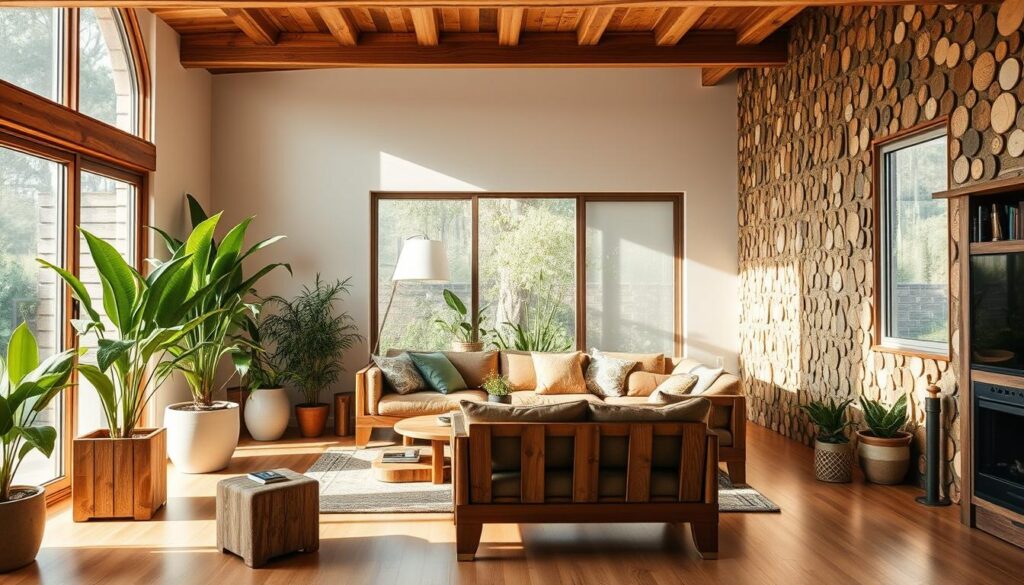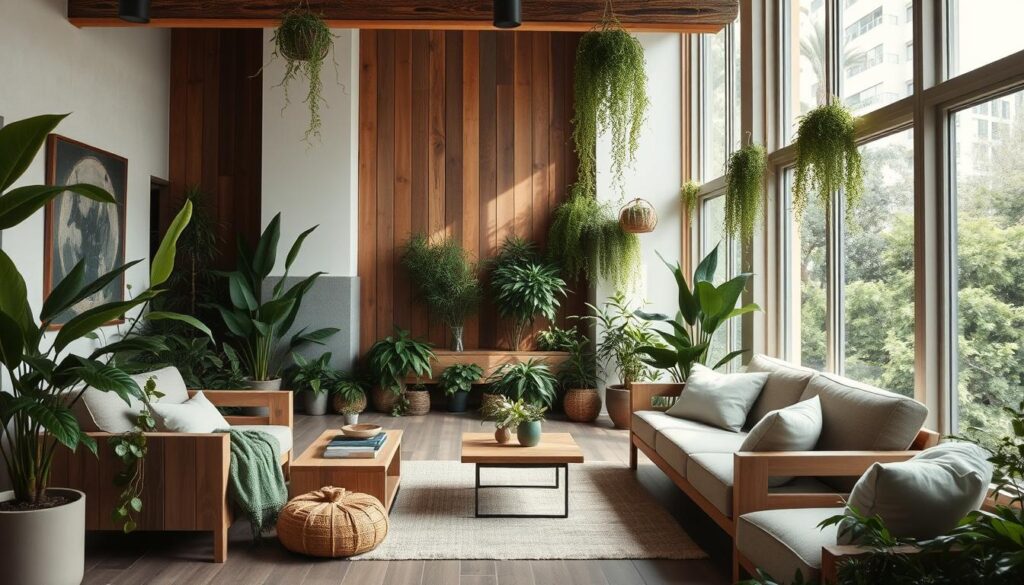Can your home be both beautiful and good for the planet? Yes, it can! Welcome to our guide on sustainable decor. We’ll dive into the world of eco-friendly home design. You’ll learn how to make your home a green oasis that’s good for you and the planet.
Key Takeaways
- Sustainable decor uses eco-friendly materials and energy-saving solutions.
- Materials like bamboo, low-VOC paints, and recycled glass tiles help the environment.
- Features like LED lights, smart homes, and good insulation save energy and money.
- Adding biophilic design and plants improves air quality and health.
- Sustainable design makes homes functional, comfy, and beautiful while being eco-friendly.
Understanding Ethical Design and Sustainability
Sustainable interior design is more than a trend. It’s a way to create spaces that are good for the planet and people. Ethical design focuses on making things in a way that’s kind to the environment. By choosing eco-friendly, vegan, and sustainable options, we can help the planet and make our homes healthier.
Defining Eco-Friendly vs. Vegan vs. Sustainable Design
Eco-friendly design uses materials that don’t harm the environment. It means using bamboo, recycled glass, and natural fibers. It also means using energy-efficient lights and appliances.
Vegan design doesn’t use animal products like leather or silk. Instead, it uses cruelty-free alternatives. Sustainable design looks at the big picture, considering how our choices affect people and the planet.
The Environmental Impact of Interior Choices
The manufacturing industry is a big polluter. It harms the environment and wildlife. By choosing sustainable design, we can help reduce pollution.
Choosing low-VOC paints and non-toxic materials is important. So is picking durable furniture. Our choices affect the planet’s health.
Key Principles of Sustainable Living
Sustainable living is about using resources wisely and reducing waste. It means using natural light and adding plants to our spaces. It also means using energy-efficient tech.
By following these principles, we can make our homes beautiful and sustainable.
“Sustainable design is not just about the materials we use, but the entire lifecycle of a product or space – from extraction to disposal or reuse. It’s a holistic approach that considers our impact on the planet and future generations.”
| Sustainable Design Principles | Benefits |
|---|---|
| Optimizing site potential | Enhances energy efficiency and minimizes environmental impact |
| Minimizing non-renewable energy consumption | Reduces carbon footprint and utility costs |
| Enhancing indoor environmental quality | Improves occupant health, comfort, and productivity |
| Using eco-friendly, renewable, and recycled materials | Reduces resource depletion and waste |
By following ethical design and sustainability, we can make our homes better for the planet and ourselves. The journey to a sustainable future begins with our choices at home.
The Benefits of Sustainable Home Design
Choosing sustainable home design brings many benefits. It helps protect the environment and improves our living spaces. We can use less energy, save water, and breathe cleaner air.
Sustainable design makes the most of the land, uses less energy, and picks eco-friendly products. The United States Green Building Council says LEED-certified buildings use 25% less energy and 11% less water. This is good for the planet and makes living spaces better.
A study showed 82% of homeowners want eco-friendly homes. Using energy-efficient appliances can cut energy use by 15%. This saves money and helps the environment.
Materials like bamboo and reclaimed wood are getting more popular, up 30% in five years. Adding indoor plants and natural light makes homes feel better. 97% of homeowners think these are key to a good home.
By choosing sustainable options, we help the planet and enjoy better homes. Sustainable living improves our health and happiness. It’s a win-win for us and the environment.

Natural and Eco-Friendly Materials for Your Home
Choosing eco-friendly materials is key to sustainable home design. Using natural and responsibly sourced items can turn your home into a peaceful, nature-inspired space. Opting for materials like bamboo, reclaimed wood, and recycled metals adds elegance and helps the planet.
Sustainable Furniture Options
Buying durable furniture means you won’t need to replace it often, saving resources. Pieces made from reclaimed or upcycled materials are good for the environment and have a special charm. Furniture with built-in storage keeps your space tidy, making it look better.
Eco-Conscious Textiles and Fabrics
Textiles are crucial for a cozy feel. Choose natural fabrics like organic cotton, linen, and wool for a greener option. Bamboo is a fast-growing alternative to traditional hardwood, perfect for flooring.
Low-VOC Paints and Finishes
Using low-VOC paints improves indoor air quality, making your home healthier. Soft grays, muted greens, and earthy browns are great for a calming look.
Embracing natural and eco-friendly materials turns your home into a sustainable haven. It looks stunning and supports your environmental values. Sustainable decor choices are a step towards a greener world, fitting an eco-conscious lifestyle.
Energy-Efficient Lighting and Smart Solutions
At the heart of sustainable home design is the focus on energy-efficient lighting and smart home tech. LED lighting has changed the game, offering big benefits over old bulbs. LEDs use less energy and last longer, saving money and being better for the planet.
Smart home technology is key in helping us manage our energy use. Smart switches and plugs let us control and schedule our energy use from afar. This helps us use energy wisely and cut down on waste. Thermostats and energy monitors help us keep our homes comfy while saving energy.
To help us go green, many states offer perks for using solar panels and Energy Star appliances. Solar water heaters and geothermal systems are also becoming popular. They help us use less non-renewable energy and save on bills.
By choosing LED lighting, smart home technology, and other energy-saving options, we help the planet and our homes. These upgrades not only cut down on waste but also make our homes more comfy and efficient.
| Feature | Benefit |
|---|---|
| LED Lighting |
|
| Smart Home Technology |
|
| Government Incentives |
|
“By embracing energy-efficient lighting and smart home technology, we can create a more sustainable and eco-friendly living environment that benefits both our homes and the planet.”
As we delve into sustainable design, using LED lighting and smart home technology is a key step. These upgrades help us save energy, cut costs, and enjoy a more comfortable home.
Sustainable Decor: A Guide to Transforming Your Home into a Green Oasis
Making your home eco-friendly is more than good for the planet. It’s about creating a space that makes you feel good and connects you to nature. By adding sustainable and biophilic design, you can turn your home into a green oasis that refreshes and uplifts you.
Creating Sustainable Focal Points
Sustainable focal points are key to an eco-friendly home. They show your commitment to living responsibly. Try repurposing furniture to add character and reduce waste. Choose pieces made locally or by artisans to share your values.
Use low-VOC paints and energy-saving lights to enhance these focal points. This creates a design that’s both beautiful and responsible.
Incorporating Biophilic Design Elements
Biophilic design brings nature inside. Place plants around your home. They clean the air, control humidity, and even improve your mood and focus.
Add natural materials like wood, stone, or rattan to enhance the biophilic design. This creates a calming, green oasis feel.
By focusing on sustainable and biophilic design, we can make our homes into green oases. These spaces nourish us and help the planet. It’s a step towards a more mindful, harmonious life.

Small changes can lead to big improvements in your green oasis. Begin with one or two sustainable or biophilic elements. Watch as your home becomes a haven of green and natural beauty.
“Connecting with nature through biophilic design can have a profound impact on our well-being and productivity.” – Jane Doe, Interior Design Expert
Upcycling and Repurposing for Sustainable Style
Upcycling and repurposing can turn your home into a green haven. Instead of throwing away old items, we can make them new again. You can repaint furniture, reupholster chairs, or make old objects into decorations. Using old windows and reclaimed wood adds history and charm to your home, cutting down on waste.
These practices save money and make your decor stand out. Thrift stores and garage sales have affordable items for DIY projects. Working with friends on upcycling projects can bring people together. Always be careful when using power tools or paints. Good tools like sandpaper and paintbrushes are key to success.
Upcycling turns old furniture into stylish pieces with sanding, painting, and reupholstering. Mason jars can become candle holders, flower vases, or kitchen organizers. Upcycling old clothes into new fashion items cuts down on waste and lets you be creative.
Upcycling and repurposing let us show our creativity while helping the planet. Learning and trying new things can improve our skills over time. Let’s follow the “Reduce, Reuse, Recycle” rule and make our homes eco-friendly.
“Upcycling is a way to give new life to old items, reducing waste and adding unique character to your home.”
Minimalist Approach to Sustainable Living
Living minimally can greatly help us live sustainably. By focusing on what’s truly important and getting rid of the rest, we can lessen our impact on the planet. This approach makes our homes more peaceful and intentional.
Decluttering with Purpose
Decluttering is more than just cleaning up. It’s about carefully choosing what we keep. We only keep things that are useful, meaningful, or reflect our values. This way, we create a space that is more mindful and purposeful.
Quality Over Quantity Philosophy
We’ve found that buying durable, high-quality items is better than constantly replacing cheap ones. This mindset helps us make better choices, choosing items that last longer. By choosing quality over quantity, we use less and help the planet.
“Minimalism is the intentional promotion of the things we most value and the removal of everything that distracts us from it.” – Joshua Becker
Minimalism is more than just cleaning up. It’s about living with intention and value. By living this way, we create a home that is peaceful, eco-friendly, and true to our values.
Supporting Local and Ethical Manufacturers
Supporting local and ethical manufacturers is key in sustainable interior design. It helps reduce our environmental footprint, boosts the local economy, and improves working conditions for artisans.
Look for LEED or NARI certifications when picking contractors or suppliers. These show a company’s dedication to green practices and fair labor.
Also, check if brands’ green claims are true. Choose companies that use eco-friendly materials and support fair labor.
- Funky Chunky Furniture offers a 25-year guarantee on their handmade furniture, using green materials and dyes.
- Sustainable home décor brand Funky Chunky Furniture offers carbon-neutral deliveries and offsets carbon emissions for Shop Pay orders.
- When furnishing your home, choose sustainable materials like reclaimed wood, bamboo, and recycled fabrics. This supports local artisans and ethical manufacturing.
By choosing wisely, we can turn our homes into green spaces. This benefits our communities and the planet.
“Sustainable design is not just about the materials we use, but the people and communities we support. Every purchase is an opportunity to make a difference.” – Jane Doe, Sustainable Living Advocate
Conclusion
Our journey towards sustainable home transformation has shown us the power of eco-friendly living. By using ethical design, we can make our homes both beautiful and useful for the planet. We can cut down on energy use and save money by choosing energy-efficient lights and appliances.
Using materials like bamboo and recycled metals makes our homes look great and helps the environment.
Embracing sustainable home transformation means we must think about biophilic design too. Adding air-purifying plants can make our homes healthier and more productive. Our outdoor spaces are also key, with water-saving gardens and renewable energy making them eco-friendly.
Looking ahead, we’re excited for the future of green design. By going green, we can inspire others and help create a better future for all.
FAQ
What is sustainable decor?
Sustainable decor means making your home eco-friendly. It’s about choosing materials and designs that are good for the planet. This includes using energy-saving items and being mindful of how much you consume.
What are the key principles of sustainable interior design?
Sustainable interior design focuses on a few key areas. It aims to use the site’s potential well, cut down on energy use, and improve air quality inside.
What are the benefits of sustainable home design?
Sustainable home design has many perks. It helps save energy, uses water wisely, and makes the air inside your home cleaner.
What are some eco-friendly material options for sustainable decor?
For sustainable decor, you can use furniture made from recycled wood. Also, look for textiles made from recycled materials or plastic bottles. And, choose paints that don’t release harmful fumes.
How can energy-efficient lighting and smart home solutions contribute to sustainable design?
Using LED lights and smart home tech can cut down on energy use. This not only saves money but also helps the planet. It makes your home more eco-friendly.
What are some strategies for incorporating biophilic design elements?
To add biophilic design, use plants and natural materials. Choose shapes that remind you of nature. This connects your home to the outdoors, improving air quality and your well-being.
How can upcycling and repurposing support sustainable interior design?
Upcycling and repurposing are great for sustainable design. They turn old items into new ones, saving money and reducing waste. It adds a personal touch to your home while being kind to the environment.
How can a minimalist approach support sustainable living?
Minimalism helps live sustainably by cutting down on waste and focusing on what’s truly needed. It makes your space more peaceful and reduces environmental harm from constant buying and throwing away.
Why is it important to support local and ethical manufacturers?
Buying from local, ethical makers helps the planet and supports your community. It cuts down on emissions from shipping and ensures fair working conditions. Always check if a brand’s claims are true by looking for certifications.




